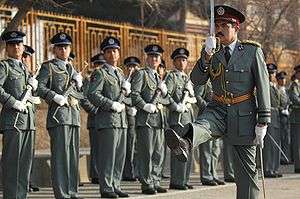Law enforcement in Afghanistan


Law enforcement in Afghanistan is one of three major components of the nation's criminal justice system, along with courts and corrections. The National Directorate of Security (NDS) is the domestic intelligence agency of the government of Afghanistan, which operates similar to that of the United States Department of Homeland Security (DHS). The Afghan National Police, which includes the Afghan Border Police and the Afghan National Civil Order Police, is the police force of Afghanistan with jurisdiction that covers the entire 34 provinces of the country.
The Afghan Border Police (ABP) is responsible for securing and maintaining the nation's borders with neighboring states as well as all international airports within the country. The mission of the Afghan National Civil Order Police (ANCOP) is to provide civil order presence patrols, prevent violent public incidents, and provide crisis and anti-terror response in urban and metropolitan environments.[1] Like the ABP, ANCOP is also under the control of the Afghan National Police (ANP), which is under the nation's Ministry of the Interior. ANCOP is divided into five Brigades, each commanded by a Brigadier General. These brigades are stationed in Kabul, Paktia, Kandahar, Herat, and Mazar-i-Sharif.
All the law enforcement agencies of Afghanistan are set up and trained by the North Atlantic Treaty Organization (NATO) states, mainly by the United States. In 2003 the mandate of the International Security Assistance Force (ISAF), under the command of NATO, was extended and expanded beyond the Kabul Province so that all parts of the country live by the rule of law. In some areas unoccupied by ISAF forces, local militias maintained control until they were gradually unarmed under programs that were started by the United Nations Office for Disarmament Affairs.
In 2007 the US military began supervising most police development, in conjunction with the U.S. Department of State, as well as coalition partners. This includes supervising recruiting, training, and operations. The United States armed forces, primarily from the National Guard, as well as other branches, began mentoring the Afghan police commanders at every level of command. This police mentoring initiative is headquartered in Camp Phoenix as part of CJTF Phoenix. As of May 2011, the Afghan National Police has 126,000 members while the NDS has between 15,000 and 30,000 employees.[2]
Historical secret police organizations
See also
- Alcohol in Afghanistan
- National Directorate of Security
- Afghan National Police
- Crime in Afghanistan
- Law of Afghanistan
- Afghan Public Protection Force
Notes
- ↑ Afghan National Security Forces Order of Battle, The Long War Journal, CJ Radin, Nov 2008.
- ↑ Pellerindate, Cheryl (May 23, 2011). "Afghan Security Forces Grow in Numbers, Quality". American Forces Press Service. United States Department of Defense. Retrieved 2011-07-10.
References
![]() This article incorporates public domain material from the Library of Congress Country Studies website http://lcweb2.loc.gov/frd/cs/.
This article incorporates public domain material from the Library of Congress Country Studies website http://lcweb2.loc.gov/frd/cs/.